King Kavantissa: A Great Character in a New Dimension
Posted on June 14th, 2023
By Dr Gamini Kariyawasam Courtesy elanka.com
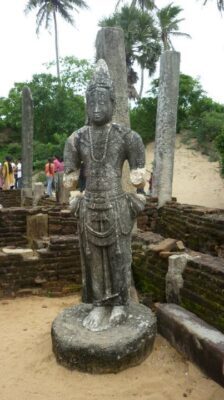
pothuvil muhudu vihaaraya king Kavanthissa ( පොතුවිල් හී ඉපැරණි මුහුදු මහා විහාරයේ ,කාවන්තිස්ස නිරිදුන්ගේ ප්රතිමාව. )
 King Kavantissa and Viharamahadevi deserve the utmost respect of the nation, just like the Gemunu kings who played a crucial role in uniting Sri Lanka in 161 AD. It was once argued by Mr. Senarath Paranavitana that King Kavantissa lost his rightful place in history due to being overshadowed by his heroic son.
King Kavantissa and Viharamahadevi deserve the utmost respect of the nation, just like the Gemunu kings who played a crucial role in uniting Sri Lanka in 161 AD. It was once argued by Mr. Senarath Paranavitana that King Kavantissa lost his rightful place in history due to being overshadowed by his heroic son.
King Kavantissa is credited with creating a prosperous land that set the stage for Prince Gamunu to lead a successful war with ten powerful Giants. His efforts to build numerous temples for the economic prosperity of the country, as well as for fostering harmony among the people and religious devotion, are clearly evident in ancient works like Maha Vamsa, Dhatu Vamsa, and Rasavahini.
Kavantissa, also known as Kaka Wanna Tissa, means someone who has black skin tone like a crow. King Kavantissa is introduced as ‘Aya Tisha’ in a cave inscription from Samangal in Ampara. Many of the pre Brahmi inscriptions found at Bowatthegala, Kusalankanda, Mottayakallu have also introduced King Kavantissa as Aya Tisha, Ragha Tisha, Gamani Tisha etc.
Kavantissa built an impressive number of one hundred and thirty-eight temples, including Datikakara Pabbata Vihara, Samudda Vihara, Chittala Pabbata Vihara, Badagal Dora Vihara, Kalaka Vihara, Valasgalu Vihara, Kolomthis Gal Vihara, Vilgama Vihara, Dukkha Katra Vihara, Uduguna Vihara, and Kotta Tissa Vihara, among others. The Dhatu Vamsa mentions the performance of pujas in these temples. The author of Thupa Vamsa also points out that the Kavantissa kings built hundreds of temples. However, the inscriptions of Kusalan Kanda and Malayasi Kanda do not clearly indicate the formation of a group of monks for the welfare of the monastic community.
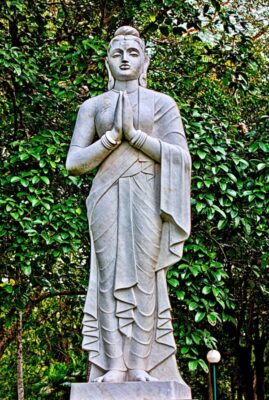
The statue of Queen Viharamahadevi ( විහාරමහා දේවිය. )
The lineage of Kavantissa’s royalty traces back to Mahanaga Uparaja, a son of King Mutasiva of Anuradhapura, who arrived in the southern land and established the Magama Kingdom. Archaeological evidence confirms that Kavantissa’s father was Gotabhaya, the son of MahaNaga.
When King Kavantissa ascended the throne after King Gotabhaya, Tamil King Elara had already established his power in the north. The ambitious Elaras sought to extend their influence to the southern land, but Kavantissa’s wisdom and foresight allowed him to anticipate this threat. He promptly organized the necessary security measures to thwart any invasion. As part of his strategy, King Kavantissa decided to detain Prince Dighabhaya, the son of a guard, along with his troops at Magam thota, a major bank on the Mahaweli River. Kavantissa had two daughters named Mahila and Samantha, who later entered monastic life, as mentioned in the author of Deepavamsa.
Kavantissa also forged alliances with the rulers of independent regions within the Rohana kingdom, namely Seru Nuwara-Siva, Giri Nuwara-Giri Abhaya, and Lona Nuwara-Mahanaga. By establishing relations with the father of Vihara Maha Devi, he gained significant support from the Kelani kingdom. King Kavantisa took great care to foster these alliances. After the construction of Seru Dagaba (during the 2nd century BC), its administration was entrusted to these regional rulers, while Kelani remained under the jurisdiction of Kavantissa.
Kavantissa’s decision to hand over his sister Soma Deviya to Prince Giri Abhaya, albeit with the intention of ensuring the prince’s safety in the event of an unexpected Elara invasion of Magama, could be seen as somewhat controversial.
According to the author of Rasavahini, Kavantissa sent his son Prince Tissa to protect the Dighavapi area and develop agriculture in the region. This demonstrates Kavantissa’s farsightedness in making necessary arrangements to prevent food shortages before engaging in a war against the enemies.
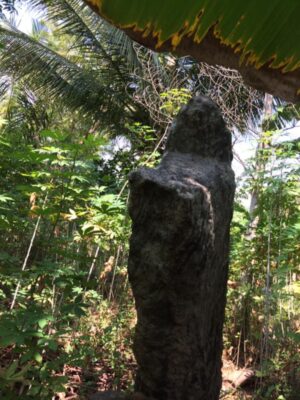
Ruins of Kavantissa Palace ( කාවන්තිස්ස මාලිගයේ නටබුන් )
It was King Kavantissa who meticulously planned the groundwork for the victorious Battle of Vijitha Pura, fought by King Gamunu in 162 BC.
King Kavantissa, who fought in the Battle of Vijitapura, pioneered the recruitment of ten powerful Warrior Giants (dasha maha yodayo) into the local army. According to an inscription in Velalullugoda Hill, a man named Aggi Datta served as the chief general of King Kavantissa. In the Kothmale area, an armory was maintained for the production of weapons.
The Mahavamsa reports that King Kavantissa invited his two sons to take oaths after grand arms giving to the Maha Sangha, where a rice pad was left over from the Sangha’s meal. According to the Mahavamsa, Gamunu was 12 years old and Tissa was 10 years old. King Kavantissa expected three commitments from his sons as they consumed the milk rice (kiribath). The princes pledged to honor the clan deities, maintain harmony between the two brothers, and avoid creating discord. The rejection of the third commitment by Prince Gamunu, who left his father’s presence declaring him a great coward, is reported in the Mahavamsa with great surprise.
The actions of the King Kavantissa, in advising their sons against waging war with Elara, were not born out of cowardice but rather a strategic decision to allow sufficient time for the development of the country and the strengthening of the army. To find out a significant source of information about Kavantissa during that time, and a comprehensive study of it could shed new light on the history of Sri Lanka.
There was a strong desire to discover the homeland of King Kavantissa, who should be honored as a great warrior in the nation’s history. Under the guidance of Nirosha Bambaranda, the Archaeology Officer of Yatalatissa Museum, an opportunity arose to explore this event. Many ruins of the Kavantissa royal palace were discovered in the Saddhatissapura village officer domain of the regional secretariat division, in an area called Tikiri Veva Godana, covering approximately 15 acres of land.
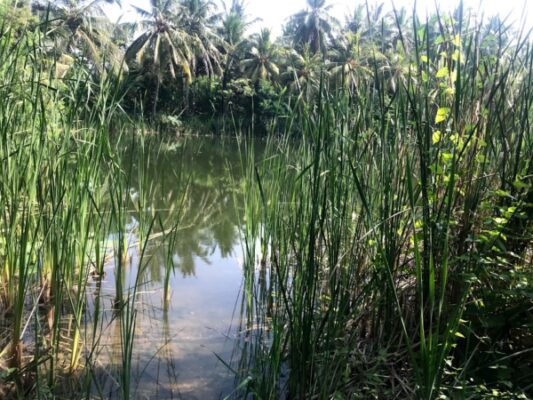
vihaaramaha devee pond ( විහාරමහාදේවී ස්නානය කළ රජ පොකුණ )
The Kavantissa royal palace, where Prince Dutugemunu spent his childhood from 205-161 AD, and Biso Pokuna (pond), where Vihara Maha Devi bathed, can still be observed in the vicinity. There is another small pond nearby known as Kok Pokuna.” It is believed that the young prince used to play water games with his brother Tissa in these Kok Pokuna.
In 2004, this significant archaeological site, located in the Great Forest, was surveyed and measured under the residence number H/TSS/2004/733, with boundary stones placed by the Department of Archaeology. However, since then, several years have passed, and it appears that the Department of Archaeology has overlooked the importance of the Kavantissa period, as no archaeological excavations have been initiated until 2019. Unfortunately, it was observed that the boundary stones placed by the Department of Archaeology in 2004 have been removed by individuals currently occupying the land.
Local villagers have mentioned the existence of stone steps leading to the four Biso ponds. Near these two ponds, remnants of a mohola sluice” dating back to the 2nd-3rd century AD, which controlled the water flow, have been found buried underground. This remarkable and delicate scientific device, used for water control in ancient irrigation technology, has been preserved and exhibited in the Yatalatissa Museum.
On the left side of the pond, there are numerous pottery shards, brick tiles, and foundation stones believed to belong to the early Anuradhapura period, along with remnants of a great wall constructed to protect the palace premises along the compound’s boundary.
Approximately 50 meters away from Biso Pond, the remains of a ruined palace can be found. These stone pillars are larger and taller than the stone pillars of the Lowa Mahapaya, indicating the existence of a multi-story building in the past. One can still see the drill marks used to assemble the stones.
Unfortunately, there is a temporary house built in the vicinity of the rocks and ponds, with a resident cultivating bananas and coconuts in the area. It is crucial that this group be relocated to another site, and the land be handed over to the Department of Archaeology to prevent further damage to the valuable artifacts at this archaeological site. The relevant authorities should pay immediate attention to rectifying the Department of Archaeology’s decision to remove Professor Raj Somadeva, who had been conducting research on this archaeological plot a few years ago.
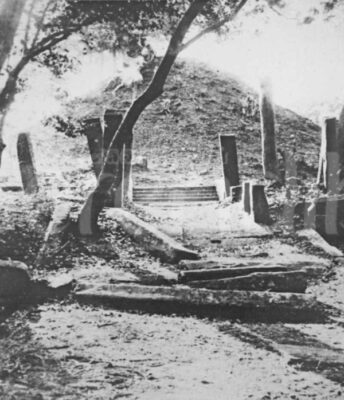
serunuvara sthupaya ( කාවන්තිස් නිරිදුන් කළ සේරුනුවර ස්තුපය ප්රතිසංස්කරණයට පෙර. )
To preserve and reveal the historical information buried in the Kingdom of Magampura, it is highly recommended that, the measurements be conducted once again, new boundary stones be placed, and archaeological excavations in the Magampura Kingdom be urgently resumed. Immediate attention from the relevant authorities is appreciated.
Dr. Gamini Kariyawasam gaminee@gmail.com